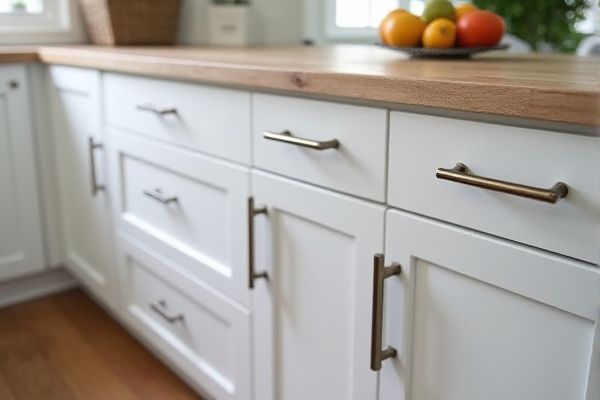
Recessed pulls offer a sleek, flush design ideal for modern, minimalist cabinetry, while bar pulls provide a more pronounced grip and a variety of styles that suit both contemporary and traditional decors. Explore the rest of the article to determine which option best complements your space and meets your functional needs.
Table of Comparison
| Feature | Recessed Pulls | Bar Pulls |
|---|---|---|
| Design | Flush with surface, minimalistic | Protruding, modern and bold |
| Installation | Requires carving into the door/drawer | Mounted externally with screws |
| Grip Comfort | Subtle grip, may be less ergonomic | Easy to hold, ergonomic |
| Style Compatibility | Contemporary, sleek, minimal | Modern, industrial, traditional options |
| Maintenance | Harder to clean inside recesses | Easy to clean, accessible surfaces |
| Durability | Less exposed to damage | Exposed but typically sturdy |
| Cost | Usually higher due to installation complexity | Generally affordable and easy to replace |
Introduction to Cabinet Pulls: Recessed vs Bar
Recessed pulls offer a sleek, minimalist design by sitting flush with the cabinet surface, making them ideal for modern and space-saving applications. Bar pulls, characterized by their protruding handle, provide a sturdy grip and versatile style suitable for various cabinet types. Your choice between recessed and bar pulls depends on aesthetic preference, functional needs, and the overall look you want to achieve in your cabinetry.
Design Aesthetics: Sleekness vs Statement
Recessed pulls offer a sleek, minimalist design that seamlessly blends with cabinetry for a modern, understated look. Bar pulls create a bold statement with their protruding form and varied finishes, enhancing visual interest and serving as a focal point. Your choice between recessed pulls and bar pulls significantly impacts the overall aesthetic tone of your space, balancing subtlety with expressive style.
Space Efficiency: Flush vs Protruding Hardware
Recessed pulls offer superior space efficiency by sitting flush with your cabinet or drawer surface, preventing any protrusion that can obstruct movement in tight areas. Bar pulls, while stylish and easy to grip, extend outward, potentially reducing clearance in small kitchens or narrow hallways. Choosing recessed pulls maximizes usable space and enhances safety by eliminating hardware that might catch on clothing or bump into adjacent fixtures.
Installation Process: Complexity and Cost
Recessed pulls typically require precision cutting into the cabinet surface, increasing installation complexity and often requiring professional tools, which can raise labor costs. Bar pulls offer a simpler installation process with straightforward surface mounting using standard screws, making them more cost-effective and beginner-friendly. Your choice between recessed and bar pulls should consider both the skill level required and the overall budget impact during installation.
Durability and Maintenance Considerations
Recessed pulls offer enhanced durability due to their flush design, reducing the risk of damage from impact or snagging, and they require minimal maintenance as dirt and grime have fewer surfaces to accumulate. Bar pulls, while often made from robust materials like stainless steel or aluminum, tend to protrude more, increasing exposure to wear and potential loosening over time, thus necessitating regular tightening and cleaning. Both types benefit from finishes that resist corrosion and fingerprints, but recessed pulls are generally preferred in high-traffic areas for their low-maintenance durability.
Functionality and Ergonomics
Recessed pulls offer a sleek, flush design that minimizes protrusion, making them ideal for tight spaces and preventing snagging, enhancing your kitchen's functionality. Bar pulls provide a comfortable grip with extended leverage, improving ergonomics especially for users with limited hand strength or dexterity. Choosing between recessed pulls and bar pulls depends on your preference for minimalist aesthetics versus ease of use and ergonomic support.
Material and Finish Options
Recessed pulls often come in materials like stainless steel, zinc alloy, and aluminum, offering finishes such as brushed nickel, matte black, and chrome for a sleek, integrated look. Bar pulls are commonly available in stainless steel, brass, and bronze with finishes including polished chrome, satin nickel, oil-rubbed bronze, and matte black, providing a more prominent design element. Both options cater to various styles and durability needs, with recessed pulls favoring minimalist aesthetics and bar pulls emphasizing bold, tactile appeal.
Best Applications for Recessed Pulls
Recessed pulls are ideal for minimalist and modern cabinetry designs where a sleek, flush surface is desired, such as in kitchens, bathrooms, and built-in furniture. Their low-profile nature reduces snagging hazards, making them perfect for tight spaces like closets and sliding doors. Additionally, recessed pulls work well in commercial environments that demand both durability and unobtrusive hardware.
Ideal Uses for Bar Pulls
Bar pulls are ideal for kitchen cabinets and modern bathroom vanities where a sleek, contemporary look is desired. Their extended length provides comfortable grip access, making them suitable for larger drawers and heavier doors. Durable materials like stainless steel enhance functionality in high-traffic areas such as commercial kitchens and office furniture.
Final Verdict: Choosing the Right Pull for Your Project
Recessed pulls offer a sleek, minimalist design ideal for modern, space-saving cabinetry, while bar pulls provide a more prominent grip suited for traditional or contemporary styles requiring ease of use. The choice depends on the project's aesthetic goals, functional needs, and ergonomics, with recessed pulls enhancing subtle elegance and bar pulls delivering practical accessibility. Prioritize the cabinetry style and user comfort to select the right pull that complements both design and functionality.
 homyna.com
homyna.com